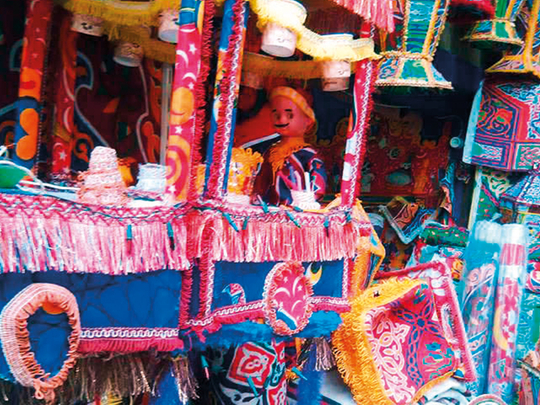
Cairo: “I wish the whole year was Ramadan,” said Mukhtar Al Hawi without taking his eyes off a piece of cloth he adroitly embellished. In the run-up to Ramadan, and during the holy month, Al Hawi has been busy meeting the high demand for his merchandise, which is used as ornaments.
The 42-year-old is one of dozens of local artisans living off decorating colourful fabrics with hand-stitching, a craft that dates back to the 10th century, during Fatimid rule in Egypt.
“During most months of the year, we suffer from a drought in sales,” the father of four told Gulf News in his workshop in Medieval Cairo. “But come Ramadan, and the gates of bounty open for us.”
Al Hawi, who inherited the job from his father, explained that he uses a type of thick fabric, called Al Khayma or a tent, to make ornamental designs, including inscriptions from the holy Quran and popular motifs. Products include ornamental table coverings, cushions, and wall hangings.
“These decorations invoke the spirit of Ramadan. They are ordered by hotels, cafes and restaurants,” added the man who is nicknamed ‘Al Hawai’ or ‘the magician’ due to his skill in the trade.
After iftar, many Egyptians go outdoors and stay up until past midnight. Culinary businesses and coffee shops usually set up Ramadan-themed tents decorated with festive lanterns and elaborately patterned ornaments in order to lure potential customers.
- Mukhtar Al Hawi | Artisan
This year’s Ramadan is particularly auspicious for Reda Al Shenawi, a shop owner in the same area.
“We have been overwhelmed with demand for tent-like fabrics printed with the picture of Mohammad Salah,” he said, referring to the Egyptian international playing for Liverpool.
The 25-year-old footballer is basking in massive popularity in his homeland with his images appearing on a wide array of merchandise including lanterns, associated with Ramadan, wall rugs and mugs.
“His brilliance is a good omen for us,” said Al Shenawi. “Lanterns wrapped up with the tent-like fabrics and carrying his image have been popular for weeks now. These lanterns ran out of stock in most areas of the country even before the start of Ramadan.”
Salah played a key role in sending Egypt to the World Cup after a 28-year hiatus.
Executing embellishments on fabrics is an arduous task, according to Haj Metwali Ebrahim.
“The craftsman starts with outlining the required design on the piece of the cloth,” Ebrahim said, sitting cross-legged. “Then he embellishes the piece using particular coloured strings and needles meant to highlight the design and make it attractive. The embellished piece is cut out and stitched together with another in harmony in order to produce the required inscription or the landscape. This work can take weeks or even months to implement.”
Like other traditional, age-old crafts in Egypt, textile embellishment does not appeal to many job seekers. “It is not financially rewarding. Besides, it requires concentration and patience,” explained Ebrahim. “Therefore, very few people are ready to do the job. One must have the spirit of an artist in order to accept the physical exhaustion and little earnings that come with this vocation.”
Ebrahim has been doing the job for years in a workshop in the vicinity of the famed Al Moaez Street in Islamic Cairo. Significantly, the place is known as Al Khayamiya Souq (tent-makers’ market), which was set up during Fatimid rule in Egypt, according to some historians.
For decades, Egypt produced the cloth embellished in silver and gold for covering the Ka’aba in Makkah. Muslims around the world face in the direction of the Ka’aba when performing their daily prayers. The covering was sent annually from Egypt in a large procession until the 1960s.
“In simple terms, Al Khaymiya is the art of carving fabrics by hand-stitching,” said Abdul Wahab Tawfik, a retired artisan in his 70s. “It is a unique Egyptian art, which began in the days of the Pharaohs, who used the tent cloth to inscribe the names of their kings and deities on them,” he said.
“Egypt used to have the best craftsmen and calligraphers. In the good days, we could not cope with the demand for the decorated tent fabrics, which were essential for everything, including street marquees needed for wedding and mourning ceremonies,” said Tawfik, who quit the job due to health problems.
“Time has changed. Now wedding parties are held at hotels and mourning ceremonies at halls annexed to mosques. Had it not been for Ramadan, the people in this craft would have starved.”











